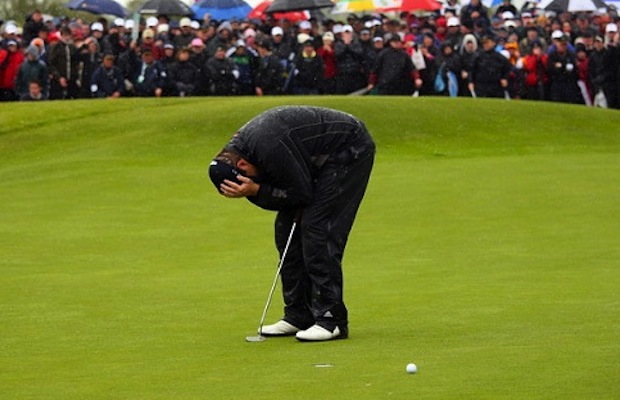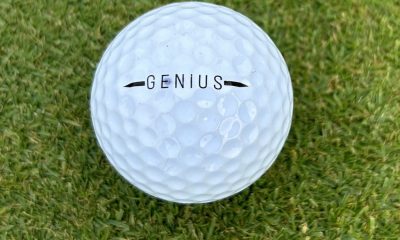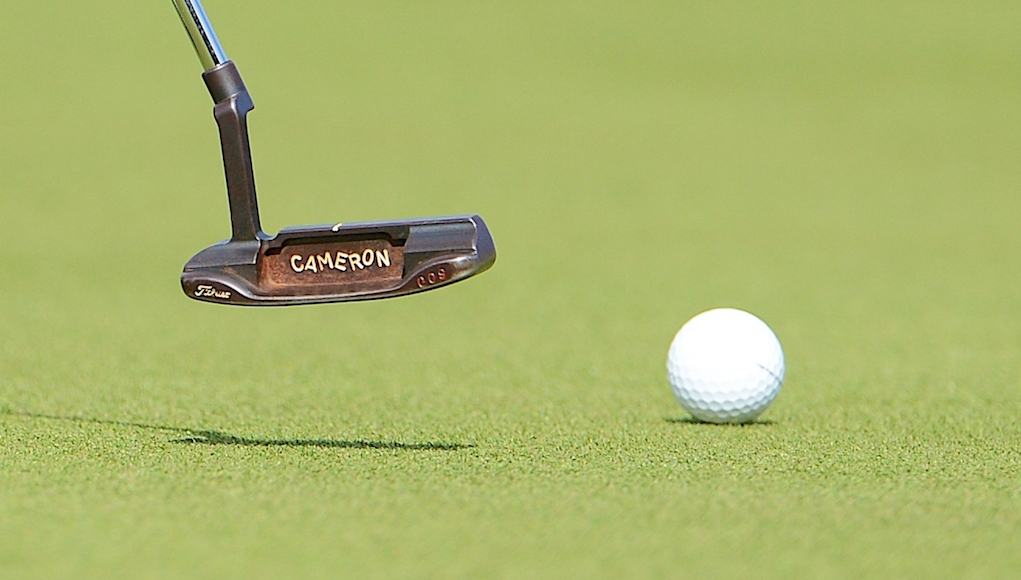Instruction
Custom Fitting: The most overlooked club in your bag

Golfers have learned that custom fit clubs are necessary to lower their scores, but they often neglect a crucial scoring club in the fitting process: the putter.
Last year, I was able to perform close to 50 club fittings in only 6 months. In 2012, I performed enough club fittings to be named a PING “Fitter of the Year.” This shows me that the golf consumer is getting smarter, but there is one issue with how the fittings have worked out. Of those 120+ fittings, not a single player directly asked me to be fit for their putter, which is used more than any other club in the bag.
Golfers tend to head to a retail store and merely pick out the putter that “feels the best” without any basis as to why they want that particular model. Now, that doesn’t mean club fitting for longer clubs carries any less importance. As found in advanced metrics on professional tours, the ability to hit it long off the tee with the driver within a reasonable distance to the fairway is arguably the No. 1 factor to scoring average. So it is very important to have a driver that optimizes distance. However, if driving is “1a” in terms of importance, then putting is most certainly “1b.”
If you are looking to get better, but you don’t have the time to work with a personal trainer to build your speed and power or a swing coach to give you the perfect swing plane, putting is the next solution to lowering your scores.
The No. 1 issue with golfers who come to me for a short game lesson is that they feel their putting stroke is off. However, the putter they use is usually more off. For a decent putter, this leads to inconsistent days on the greens, and it can lead to less-skilled putters developing bad habits.
The putter is a club that you usually only have to fit once, and unless you are a junior golfer who is growing or you develop some sort of physical ailment, you could possibly keep it for the rest of your playing career. At our facility at Deerpath Golf Course in Lake Forest, Ill., I tell students that the $75 they spend on a putting evaluation could save them thousands of dollars in putter trial and error.
With the use of SAM Puttlab and high-speed video, these are the areas that I look for when fitting a putter and the effects that each could have on the stroke.
No. 1: Length and Lie Angle
The length of the putter has a tremendous impact on the shape of your stroke. The putter is meant to swing on the inclined plane on which the shaft rests. If the length of the putter is longer, the putter will need to arc more around your body, while a shorter putter can travel a bit more “straight back and straight through.”
A putter that is not the right length will affect the path of the stroke, which can have an influence on making consistent contact and controlling the rotation of the putter face. The lie angle has an effect on the ability to hit the center of the putter. At the speeds we swing the putter, there may not be enough force to send a ball off line from an off-center hit, but it will have an effect on distance control.
Throughout this article, I will reference measurements and results from the putting stroke of a sample student with his original putter, which was center-shafted and face-balanced. After a putting fitting, I then took his measurements with a properly-fit heel-shafted, toe-balanced putter, and I will also reference those results as well.
The original putter lie was incorrect and lead to toe contact.
After the switch, contact started to move toward the center of the putter face. There are a few inconsistencies in the contact, which can be improved with drills.
No. 2: Head Type/Shaft Hosel Design
Aiming is the most important aspect to putting and the putter you select has a big effect on how well you aim at the target. It is very common to see even a tour-caliber player have issues aiming the putter directly at their target.
It can be argued that it is more important to be consistent with where you aim the putter and work with that, but if you truly do not want to compensate in your putting stroke, aiming the putter at the target is the first step. The head design has a huge effect on this.
My student aimed his center-shafted, face-balanced putter 1.3 degrees closed, and although he was very consistent, he had to manipulate his putter during his stroke to get the putter face “square” at impact. The other thing to note was that the putter was set up on the toe, which was consistent with the impact point. This was the No. 1 factor that determined a switch from a center-shafted putter to a heel-shafted putter was needed. The results were a much improved aim with a similar level of consistency shown below.
The putter head design can have a huge effect on how much the putter face rotates throughout the stroke, as well as an effect on the resulting path. With his original putter, my student had the path and face rotation results shown below.
My student switched to a center-shafted, face-balanced putter because he felt he had “too much arc” in his stroke, and center-shafted, face-balanced putters are known to create a more straight-back, straight-through path. While he thought his stroke was more linear, its arc was actually traveling to the left, or out-to-in. A more pressing issue was the inconsistency of his backstroke, however, which is represented by the dotted line above.
The result of my student’s original path and his initial aim was that he opened the putter during the backstroke and then “held off” the rotation of the putter face on the way through in an attempt to keep the putter face square. He was surprisingly consistent, but we saw how difficult it was for him to find the center of the putter face making these compensations.
Below are the results from the properly-fit putter:
When the student switched to a properly fit putter, the path became more neutral. His stroke also changed from outside-in to having just a little bit of arc, which got him closer to his goal of having a straight-back, straight-through stroke.
With a properly fit putter, the putter head rotated more freely and he was able to release it through the stroke. There is still work to do, because the putter was still about 2 degrees open at impact after the change, but it is an improvement from 2.9 degrees open with the old putter that effectively had him “cutting” his putts.
No. 3: Loft
Loft is an aspect of putter fitting that depends on the golf courses you typically play. It’s needed on a putter because when the golf ball rests on a green, it settles down into the grass ever so slightly. This means that we need to launch the golf ball into the air a little bit so it can get on the grass and start rolling as fast as possible. This has a huge influence on speed and distance control in putts.
There are a few factors to look at including what your green speeds typically are at your home course. The slower the green, the more loft you need on the putter. If you are putting at Augusta National, maybe you can get away with only 1 degree of loft on your putter, but at your home course with a green speed of 8, you may need 3-to-4 or more degrees of loft.
The other factor is the hand position and the amount of “delofting” a golfer does through impact. For example, on a green speed of 11, we would like the golf ball to launch at approximately 2 degrees. This could be achieved with a 3-degree putter that has 1 degree of deloft at impact and a neutral rise angle.
If you are a putter like Matt Kuchar, however, who has a serious putter deloft through impact and a level rise angle through impact, then you may need 5, 6 or even 7 degrees of loft on your putter.
A putter like Zach Johnson, who has his hands positioned behind the ball at address and through the stroke, can use less loft on his putter to achieve a desired launch angle.
After getting fit for a new putter, my student had a slight improvement in rise-angle-to-loft and his putts were launching with less backspin. For most part, the launch angle of 4 degrees up stayed the same.
No. 4: Grip
The grip on a putter works just like a golf club. If you have a putter that does not allow the putter to rotate square to the path of the club, then adjusting the grip can help this problem along with putter head design.
If you are player with too little face rotation, then a smaller grip size can help you release the putter head. A larger putter grip can help minimize face rotation or even help take the hands out of the stroke for golfers who struggle to keep their hands steady. These are considerations that can be looked at from the rotational diagrams we saw above.
Conclusion
As established in the categories above, there is a lot that goes into picking the right putter, and quite frankly, an off-the-rack putter is probably not the best one for you. If you take the time to get fit for a putter, it can save you money down the road and some closet space.
There were numerous areas that I could have worked on with my student with his old putter, and we could have spent hours trying to fix his flaws. Through one 60-minute session and a new putter, however, we were able to improve several areas in far less time and with far less effort. Fewer dollars spent and fewer strokes taken is always a good combination.
Do yourself a favor and go through a putter fitting!
Instruction
The Wedge Guy: Beating the yips into submission

There may be no more painful affliction in golf than the “yips” – those uncontrollable and maddening little nervous twitches that prevent you from making a decent stroke on short putts. If you’ve never had them, consider yourself very fortunate (or possibly just very young). But I can assure you that when your most treacherous and feared golf shot is not the 195 yard approach over water with a quartering headwind…not the extra tight fairway with water left and sand right…not the soft bunker shot to a downhill pin with water on the other side…No, when your most feared shot is the remaining 2- 4-foot putt after hitting a great approach, recovery or lag putt, it makes the game almost painful.
And I’ve been fighting the yips (again) for a while now. It’s a recurring nightmare that has haunted me most of my adult life. I even had the yips when I was in my 20s, but I’ve beat them into submission off and on most of my adult life. But just recently, that nasty virus came to life once again. My lag putting has been very good, but when I get over one of those “you should make this” length putts, the entire nervous system seems to go haywire. I make great practice strokes, and then the most pitiful short-stroke or jab at the ball you can imagine. Sheesh.
But I’m a traditionalist, and do not look toward the long putter, belly putter, cross-hand, claw or other variation as the solution. My approach is to beat those damn yips into submission some other way. Here’s what I’m doing that is working pretty well, and I offer it to all of you who might have a similar affliction on the greens.
When you are over a short putt, forget the practice strokes…you want your natural eye-hand coordination to be unhindered by mechanics. Address your putt and take a good look at the hole, and back to the putter to ensure good alignment. Lighten your right hand grip on the putter and make sure that only the fingertips are in contact with the grip, to prevent you from getting to tight.
Then, take a long, long look at the hole to fill your entire mind and senses with the target. When you bring your head/eyes back to the ball, try to make a smooth, immediate move right into your backstroke — not even a second pause — and then let your hands and putter track right back together right back to where you were looking — the HOLE! Seeing the putter make contact with the ball, preferably even the forward edge of the ball – the side near the hole.
For me, this is working, but I am asking all of you to chime in with your own “home remedies” for the most aggravating and senseless of all golf maladies. It never hurts to have more to fall back on!
Instruction
Looking for a good golf instructor? Use this checklist

Over the last couple of decades, golf has become much more science-based. We measure swing speed, smash factor, angle of attack, strokes gained, and many other metrics that can really help golfers improve. But I often wonder if the advancement of golf’s “hard” sciences comes at the expense of the “soft” sciences.
Take, for example, golf instruction. Good golf instruction requires understanding swing mechanics and ball flight. But let’s take that as a given for PGA instructors. The other factors that make an instructor effective can be evaluated by social science, rather than launch monitors.
If you are a recreational golfer looking for a golf instructor, here are my top three points to consider.
1. Cultural mindset
What is “cultural mindset? To social scientists, it means whether a culture of genius or a culture of learning exists. In a golf instruction context, that may mean whether the teacher communicates a message that golf ability is something innate (you either have it or you don’t), or whether golf ability is something that can be learned. You want the latter!
It may sound obvious to suggest that you find a golf instructor who thinks you can improve, but my research suggests that it isn’t a given. In a large sample study of golf instructors, I found that when it came to recreational golfers, there was a wide range of belief systems. Some instructors strongly believed recreational golfers could improve through lessons. while others strongly believed they could not. And those beliefs manifested in the instructor’s feedback given to a student and the culture created for players.
2. Coping and self-modeling can beat role-modeling
Swing analysis technology is often preloaded with swings of PGA and LPGA Tour players. The swings of elite players are intended to be used for comparative purposes with golfers taking lessons. What social science tells us is that for novice and non-expert golfers, comparing swings to tour professionals can have the opposite effect of that intended. If you fit into the novice or non-expert category of golfer, you will learn more and be more motivated to change if you see yourself making a ‘better’ swing (self-modeling) or seeing your swing compared to a similar other (a coping model). Stay away from instructors who want to compare your swing with that of a tour player.
3. Learning theory basics
It is not a sexy selling point, but learning is a process, and that process is incremental – particularly for recreational adult players. Social science helps us understand this element of golf instruction. A good instructor will take learning slowly. He or she will give you just about enough information that challenges you, but is still manageable. The artful instructor will take time to decide what that one or two learning points are before jumping in to make full-scale swing changes. If the instructor moves too fast, you will probably leave the lesson with an arm’s length of swing thoughts and not really know which to focus on.
As an instructor, I develop a priority list of changes I want to make in a player’s technique. We then patiently and gradually work through that list. Beware of instructors who give you more than you can chew.
So if you are in the market for golf instruction, I encourage you to look beyond the X’s and O’s to find the right match!
Instruction
What Lottie Woad’s stunning debut win teaches every golfer

Most pros take months, even years, to win their first tournament. Lottie Woad needed exactly four days.
The 21-year-old from Surrey shot 21-under 267 at Dundonald Links to win the ISPS Handa Women’s Scottish Open by three shots — in her very first event as a professional. She’s only the third player in LPGA history to accomplish this feat, joining Rose Zhang (2023) and Beverly Hanson (1951).
But here’s what caught my attention as a coach: Woad didn’t win through miraculous putting or bombing 300-yard drives. She won through relentless precision and unshakeable composure. After watching her performance unfold, I’m convinced every golfer — from weekend warriors to scratch players — can steal pages from her playbook.
Precision Beats Power (And It’s Not Even Close)
Forget the driving contests. Woad proved that finding greens matters more than finding distance.
What Woad did:
• Hit it straight, hit it solid, give yourself chances
• Aimed for the fat parts of greens instead of chasing pins
• Let her putting do the talking after hitting safe targets
• As she said, “Everyone was chasing me today, and managed to maintain the lead and played really nicely down the stretch and hit a lot of good shots”
Why most golfers mess this up:
• They see a pin tucked behind a bunker and grab one more club to “go right at it”
• Distance becomes more important than accuracy
• They try to be heroic instead of smart
ACTION ITEM: For your next 10 rounds, aim for the center of every green regardless of pin position. Track your greens in regulation and watch your scores drop before your swing changes.
The Putter That Stayed Cool Under Fire
Woad started the final round two shots clear and immediately applied pressure with birdies at the 2nd and 3rd holes. When South Korea’s Hyo Joo Kim mounted a charge and reached 20-under with a birdie at the 14th, Woad didn’t panic.
How she responded to pressure:
• Fired back with consecutive birdies at the 13th and 14th
• Watched Kim stumble with back-to-back bogeys
• Capped it with her fifth birdie of the day at the par-5 18th
• Stayed patient when others pressed, pressed when others cracked
What amateurs do wrong:
• Get conservative when they should be aggressive
• Try to force magic when steady play would win
• Panic when someone else makes a move
ACTION ITEM: Practice your 3-6 foot putts for 15 minutes after every range session. Woad’s putting wasn’t spectacular—it was reliable. Make the putts you should make.
Course Management 101: Play Your Game, Not the Course’s Game
Woad admitted she couldn’t see many scoreboards during the final round, but it didn’t matter. She stuck to her game plan regardless of what others were doing.
Her mental approach:
• Focused on her process, not the competition
• Drew on past pressure situations (Augusta National Women’s Amateur win)
• As she said, “That was the biggest tournament I played in at the time and was kind of my big win. So definitely felt the pressure of it more there, and I felt like all those experiences helped me with this”
Her physical execution:
• 270-yard drives (nothing flashy)
• Methodical iron play
• Steady putting
• Everything effective, nothing spectacular
ACTION ITEM: Create a yardage book for your home course. Know your distances to every pin, every hazard, every landing area. Stick to your plan no matter what your playing partners are doing.
Mental Toughness Isn’t Born, It’s Built
The most impressive part of Woad’s win? She genuinely didn’t expect it: “I definitely wasn’t expecting to win my first event as a pro, but I knew I was playing well, and I was hoping to contend.”
Her winning mindset:
• Didn’t put winning pressure on herself
• Focused on playing well and contending
• Made winning a byproduct of a good process
• Built confidence through recent experiences:
- Won the Women’s Irish Open as an amateur
- Missed a playoff by one shot at the Evian Championship
- Each experience prepared her for the next
What this means for you:
• Stop trying to shoot career rounds every time you tee up
• Focus on executing your pre-shot routine
• Commit to every shot
• Stay present in the moment
ACTION ITEM: Before each round, set process goals instead of score goals. Example: “I will take three practice swings before every shot” or “I will pick a specific target for every shot.” Let your score be the result, not the focus.
The Real Lesson
Woad collected $300,000 for her first professional victory, but the real prize was proving that fundamentals still work at golf’s highest level. She didn’t reinvent the game — she simply executed the basics better than everyone else that week.
The fundamentals that won:
• Hit more fairways
• Find more greens
• Make the putts you should make
• Stay patient under pressure
That’s something every golfer can do, regardless of handicap. Lottie Woad just showed us it’s still the winning formula.
FINAL ACTION ITEM: Pick one of the four action items above and commit to it for the next month. Master one fundamental before moving to the next. That’s how champions are built.
PGA Professional Brendon Elliott is an award-winning coach and golf writer. You can check out his writing work and learn more about him by visiting BEAGOLFER.golf and OneMoreRollGolf.com. Also, check out “The Starter” on RG.org each Monday.
Editor’s note: Brendon shares his nearly 30 years of experience in the game with GolfWRX readers through his ongoing tip series. He looks forward to providing valuable insights and advice to help golfers improve their game. Stay tuned for more Tips!






























Rick Wright
Jul 1, 2014 at 12:31 pm
As the developer of the first comprehensive putter fitting system in golf back in 1996, I can speak from experience. A properly fit putter can certainly compliment putting performance. However, putter fitting is best done only as a part of instruction. Otherwise, you may only be treating symptoms.
Tim Tomlinson
Jul 1, 2014 at 11:55 am
Great article Scott! I completely agree with you as most golfers do not take the time to get fitted for a putter. I am a sales rep for SAM PuttLab so if anybody would like any additional information on the SAM PuttLab please let me know. Thanks and keep up the good work!
tim.tomlinson@scienceandmotion.com
CS
Jun 29, 2014 at 2:23 am
The problem is going to get worse…….. if we have all this information now, why do John Q Public amateurs need to pay you PGA professionals your high fees? The clients can go now to non-PGA golf fitting shops and get the same info from guys that don’t charge $150 to $300 an hour. Or just use the web like this and use common sense.
Tom
Jun 29, 2014 at 12:59 am
I work as a custom fitter and most people (95%) who want to be fitted for a putter can’t break 90 anyway. Learn how to putt and come back and talk to me. I am not paid to give lessons. Golfers are just an asinine group of people, at times. Learn the fundamentals and read The Art of Putting by Dr. Bob Rotella and their game would improve immensely. The putter is not to blame when you cannot putt!
Mike Mullins
Jul 11, 2014 at 9:51 am
As the article discusses, I think it is very important to have every club fitted as I just had my putter fitted by someone who took the time to understand me and my stroke, explained my tendencies, and recommended a couple of things which help me improve.
I’m glad I didn’t run into you and your attitude about “asinine” golfers. because if you didn’t have them coming in to where you work, you’d be selling worms at a Bait shop.
Pingback: Custom Fitting: The most overlooked club in your bag | Spacetimeandi.com
Tom Stickney
Jun 27, 2014 at 10:23 pm
See scienceandmotion.com for a listing of teachers with the Sam Puttlab. It’s an amazing tool; I love mine.
Adam B.
Jun 28, 2014 at 4:45 pm
Tom,
Do most instructors that have SAM Puttlab use it to improve the way people putt with their current putter or use it to test a variety of putters? In other words, would it be able to tell me what kind of putter I need based on my current putter?
Tom Stickney
Jun 29, 2014 at 9:48 am
Adam. It can compare putters and help you also see which head design best matches your stroke.
William Ramsey
Jun 27, 2014 at 4:45 pm
I think this is really cool. Is there a way to find club fitters with this kind of knowledge/technology/ability?
Merty Huckle
Jun 27, 2014 at 1:55 pm
Great write up!
Dan P
Jun 27, 2014 at 1:29 pm
Getting custom fit on a SAM Puttlab was the best decision I made this season. I had an off the rack Nike Method 001 and had struggled with distance control for years. Turns out the putter had 0* of loft, a quick session on the SAM Puttlab and a quick bend in loft and I was on my way. The ball rolls so much truer than it used to.